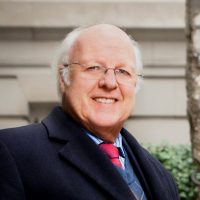From Bonn to Berlin: Seventy Years of the FRG

Jackson Janes
President Emeritus of AGI
Jackson Janes is the President Emeritus of the American-German Institute at the Johns Hopkins University in Washington, DC, where he has been affiliated since 1989.
Dr. Janes has been engaged in German-American affairs in numerous capacities over many years. He has studied and taught in German universities in Freiburg, Giessen and Tübingen. He was the Director of the German-American Institute in Tübingen (1977-1980) and then directed the European office of The German Marshall Fund of the United States in Bonn (1980-1985). Before joining AICGS, he served as Director of Program Development at the University Center for International Studies at the University of Pittsburgh (1986-1988). He was also Chair of the German Speaking Areas in Europe Program at the Foreign Service Institute in Washington, DC, from 1999-2000 and is Honorary President of the International Association for the Study of German Politics .
Dr. Janes is a member of the Council on Foreign Relations, the International Institute for Strategic Studies, the Atlantic Council of the United States, and American Purpose. He serves on the advisory boards of the Berlin office of the American Jewish Committee, and the Beirat der Zeitschrift für Außen- und Sicherheitspolitik (ZfAS). He serves on the Selection Committee for the Bundeskanzler Fellowships for the Alexander von Humboldt Foundation.
Dr. Janes has lectured throughout Europe and the United States and has published extensively on issues dealing with Germany, German-American relations, and transatlantic affairs. In addition to regular commentary given to European and American news radio, he has appeared on CBS, CNN, C-SPAN, PBS, CBC, and is a frequent commentator on German television. Dr. Janes is listed in Who’s Who in America and Who’s Who in Education.
In 2005, Dr. Janes was awarded the Officer’s Cross of the Order of Merit of the Federal Republic of Germany, Germany’s highest civilian award.
Education:
Ph.D., International Relations, Claremont Graduate School, Claremont, California
M.A., Divinity School, University of Chicago
B.A., Sociology, Colgate University
Expertise:
Transatlantic relations, German-American relations, domestic German politics, German-EU relations, transatlantic affairs.
__
When I first visited Bonn in 1973, I had just read John le Carré’s “A Small Town in Germany.” Bonn was as he described it—a comfortable low-key atmosphere vastly different from the other European capitals. Chancellor Konrad Adenauer had pushed for it to be the capital of the new Federal Republic in 1949—not only because he lived down the river a bit, but also because he felt it would be less intimidating as Germany got started rebuilding and reinventing itself after World War II.
To be sure, it was always formally understood to be a temporary arrangement until German unification took place. But after the Wall was built in 1961 and Willy Brandt’s government started working on reducing tensions with Moscow, Eastern Europe, and the GDR in the early 1970s, there was more of a sense that Bonn was going to be not so temporary after all. I recall so many times hearing so many people in Germany say to me that, of course unification will come someday but “not in my lifetime.” So Bonn was thought to be a permanent provisional capital as the government expanded and spread out around that picturesque small town on the Rhine.
Unification will come someday but “not in my lifetime.”
Eventually that forty years was to be known as the Bonn Republic that shaped West Germany after 1949. As the capital, Bonn was a bit of a bubble in which the political/journalist/lobbyist cadres all ran around each other in circles they knew all too well. After all, it was a small town.
But then in 1989 came the unexpected: the fall of the Wall and the race toward unification. By October 3, 1990, the provisional capital faced the prospect of becoming the former capital. On June 20, 1991, the decision was made by the Bundestag to make Berlin the capital of unified Germany. The vote was close—338 for, 320 against. It was divided along regional lines, with the west and south of the Federal Republic competing with the north, and the east now enhanced with the five new states emerging out of the old GDR. In fact, it was those eastern representatives who made the difference.
The argument for Bonn was driven to an extent by concerns about Berlin’s past connection to Nazi Germany. But there were other advantages such as Bonn being closer to Brussels and located in Germany’s wealthiest region. Berlin seemed far away. But a speech by then Bundestag president Wolfgang Schäuble was a tipping point before the final vote was taken. Schäuble argued that it was not a choice between Berlin and Bonn, the cost of moving, or a loss of jobs.: “What is at stake is the future of Germany. That’s the crucial question.” He called on legislators to be “representative[s] of the entire German people,” noting that for forty years no one questioned that when reunification came, the government and parliament would have their seat in Berlin. Berlin, he said, is the “symbol for unity and freedom, for democracy and constitutional statehood for all of Germany.”
Berlin is the “symbol for unity and freedom, for democracy and constitutional statehood for all of Germany.”
And so, the Bonn Republic gave way to the Berlin Republic.
Thirty years later, Bonn has managed to take advantage of some of the arguments made to keep it as the capital. Its central location near Brussels and the infrastructure that the government left behind when it moved to Berlin opened options for other international organizations to move in, such as the United Nations. Two major corporations—Deutsche Telekom and DHL—became all-pervasive giants. Today, Bonn holds on to its title not as the capital city but as Bundesstadt, echoing its former legacy.
And thirty years later, Berlin continues to expand not only as the capital of Germany, but as one of the most important capitals of Europe. The infrastructures of the two sides of a divided Berlin have merged and the city has become the largest in Germany, approaching 3.8 million residents in Berlin proper, with over 6 million in the larger metropolitan area.
In many ways the city struggles with the burdens and demands of this growth. The postwar division lingers in the asymmetries of the city’s legacies and in the psyches of its residents, east and west. The poster child of inefficiency is an endless effort to build a major airport. But the emergence of a modernized Potsdamer Platz, glitzy embassies, and new government buildings have been transforming much of the core of the capital over the past thirty years.
Berlin has begun to become what those who voted for it in 1991 hoped it might be.
As the seventieth anniversary of the Federal Republic of Germany is marked this month, Berlin has begun to become what those who voted for it in 1991 hoped it might be. It is a city that embodies both the remembrance of the past —all of it, for better and for worse—and in particular it represents the fulfillment of unification, complete with the opportunities, challenges, obstacles, and responsibilities that have accompanied it. But like Germany’s history, Berlin is a complex place, shaped by memories, monuments, and memorials. That includes those that were part of the GDR and the millions of Germans who lived through its four decades. That part of unification remains a work in progress and will likely endure for many years to come.
It is also shaped by a constant need for renewal. David Frum recently argued in his refection on Germany’s 70th anniversary, “After 70 years of self-examination, modern Germany has some lessons to teach and some wisdom to impart from its own hard experience to those perhaps excessively proud of their own imperfect past and deteriorating present.”
Bonn was the right place for the first chapter of the Federal Republic. Despite its shortcomings, it was the first arena in which postwar Germany could begin to rebuild and renew the foundations of a healthy democracy. That opportunity was withheld from those in the GDR until the people finally demanded it.
Berlin is the right place for the second chapter—what historian Fritz Stern called Germany’s second chance. He labeled it as both “celebratory and admonishing,” saying “a great gift has been bestowed on the country, and it required protection. The past should serve as a lesson.”
Neil MacGregor proclaimed in his brilliant work “Germany: Memories of a Nation” that Germany’s struggle to deal with its historical inheritance and its complex and changing memories is unique. Perhaps that is particularly poignant when one stands before the Brandenburg Gate in Berlin—the symbol of both division and unity. I once told friends after a dinner to walk up to the gate and stand beneath it…and then to never take things for granted again.
Read more on the 70th anniversary of the Federal Republic of Germany
Seventy Years as a Country of Immigrants: What’s Next for Germany? by Susanne Dieper
From Fear to Friendship: Franco-German Relations in 1949 and 2019 by Lily Gardner Feldman
Sovereignty Regained, Economic Order Uncertain: Germany’s Social Market Economy at 70 by Peter Rashish
The 70th Anniversary of the Federal Republic of Germany: Challenges and Opportunities for the German-American Future and the Atlantic Community by Jeff Rathke
The Past Shapes the Future: The German Constitution at 70 by Stephen F. Szabo









